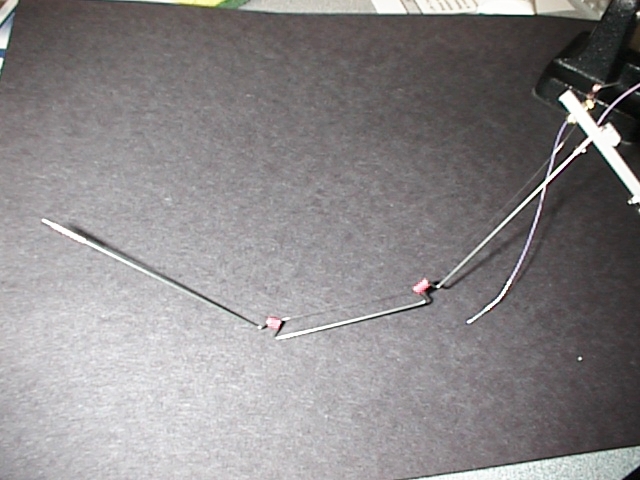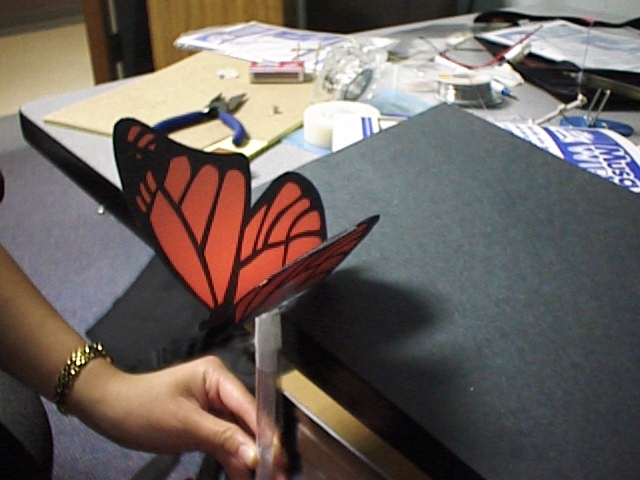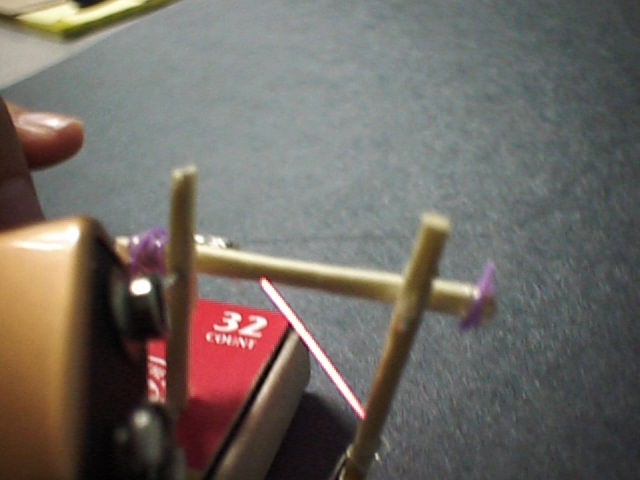CS 154: HMC Robotics Lab 2
Purpose This lab began as
an attempt to design an autonomous robot using muscle wire ( NiTinol). Muscle wire is
a nickle titanium alloy which contracts when heated. The lab evolved into an
exploration of the limits of muscle wire.
Part 1: Matchbox
Leg
We bagan with a fairly simple idea, an articulated leg which would
pull and lift so that it could progress without dragging its feet.  We did not have a lot of materials with which
to experiment, so we created a prototype leg out of matchsticks and a matchbox.
This prototype worked once, after which it refused to work again (see "What we
learned" below).
We did not have a lot of materials with which
to experiment, so we created a prototype leg out of matchsticks and a matchbox.
This prototype worked once, after which it refused to work again (see "What we
learned" below).
Part 2: Staquito Leg Modification
We then
decided to cannabalize parts from a broken Stiquito robot. This consisted mostly
of a leg and a piece of grey plastic. To this, we developed a better design
which uses the leg as a conductor to power the muscle wire.  This part taught us some basic techniques for
making the pieces for the leg (for example, use an Xacto type knife to cut
copper tubing as it does not cause the tubing to collapse upon itself). This leg
worked much better than the matchbox monstrosity. This leg uses about 10cm of
muscle wire and about as much music wire (which is quite usefull as it can be
bent in practically any shape you desire). We powered it with 3V and it worked
fine. However, 9V proved a little excessive for the top wire (see "What we
learned" below).
This part taught us some basic techniques for
making the pieces for the leg (for example, use an Xacto type knife to cut
copper tubing as it does not cause the tubing to collapse upon itself). This leg
worked much better than the matchbox monstrosity. This leg uses about 10cm of
muscle wire and about as much music wire (which is quite usefull as it can be
bent in practically any shape you desire). We powered it with 3V and it worked
fine. However, 9V proved a little excessive for the top wire (see "What we
learned" below).
Part 3: Advanced Leg
The third leg for this
project was developed from a design in the Advanced Stiquito book. This leg uses
one long piece of muscle wire, a longer piece of music wire and some insulation
cannabalized from some 12guage wire that was lying around. This design uses the
tension of the unheated muscle wire to keep the muscle wire from contacting the
conducting music wire.  This leg is the first
which has been able to keep working. It is also the only one which we have made
so far that can lift weight (we lifted some legos as a test). This leg also does
not seem to mind the 9V power supply that killed the other legs.
This leg is the first
which has been able to keep working. It is also the only one which we have made
so far that can lift weight (we lifted some legos as a test). This leg also does
not seem to mind the 9V power supply that killed the other legs.
Part
4: Butterfly
We then decided that it would be nice to have something
that is pretty. We decided that a butterfly would be nice.  (click on pic for more...) One of
the project books had a basic design which we modified to support our heavy
wings. The basic idea is that the muscle wire which runs down the center of a
tube pulls a center "wing lifting" piece. The wire contracts and the wings flap
(see Bryce for a demo). This
project really disliked 9V but was a little slow with 3V so we thought we would
try it. Oops.
(click on pic for more...) One of
the project books had a basic design which we modified to support our heavy
wings. The basic idea is that the muscle wire which runs down the center of a
tube pulls a center "wing lifting" piece. The wire contracts and the wings flap
(see Bryce for a demo). This
project really disliked 9V but was a little slow with 3V so we thought we would
try it. Oops.
Where to now?
The idea behind the leg
development is to find something that will work for an autonomous light seeking
robot. We invision an robot which walks by inching along.
What we
learned
First and foremost, muscle wire is fairly sensitive to an
improper power supply. We got lots of smoking wires when we tried to give it too
much power. Oops. The matchbox robot even glows.  It seems from our experimentation, that shorter
wires are much more likely to burn out quickly. Muscle wire also must be under a
well balanced tension. If it is not under enough tension then it will just sit
there and flex but not pull. If it is under too much tension, things do not work
right and you can damage the wire. Muscle wire also has an interesting reaction
to fire. We played with a short piece of muscle wire and a couple of matches.
The wire would move towards the flame until it was straight. Pretty spiff. We
also tried to convince the wire that it wanted to stay in a spiral, this was not
a success.
It seems from our experimentation, that shorter
wires are much more likely to burn out quickly. Muscle wire also must be under a
well balanced tension. If it is not under enough tension then it will just sit
there and flex but not pull. If it is under too much tension, things do not work
right and you can damage the wire. Muscle wire also has an interesting reaction
to fire. We played with a short piece of muscle wire and a couple of matches.
The wire would move towards the flame until it was straight. Pretty spiff. We
also tried to convince the wire that it wanted to stay in a spiral, this was not
a success.
Conclusions
Muscle wire is neat. It is relatively
inexpensive, fairly easy to make something that works. However, it also requires
some careful engineering to get a setup that will do exactly what you want and
getting the wire properties right can be a touch tricky at times as well.